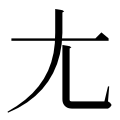尢
| ||||||||
| ||||||||
| ||||||||
 | ||||||||
| ||||||||
Translingual edit
| Stroke order | |||
|---|---|---|---|
 | |||
Han character edit
尢 (Kangxi radical 43, 尢+0, 3 strokes, cangjie input 大山 (KU) or 難大山 (XKU), four-corner 40010, composition ⿸𠂇乚)
- Kangxi radical #43, ⼪.
Derived characters edit
- Appendix:Chinese radical/尢
- 𧥩, 𢍽, 𡯥, 𩲄, 𩵛, 无, 𡵈, 𦬍, 𧗢
Descendants edit
References edit
- Kangxi Dictionary: page 298, character 2
- Dai Kanwa Jiten: character 7539
- Dae Jaweon: page 593, character 1
- Hanyu Da Zidian (first edition): volume 1, page 551, character 10
- Unihan data for U+5C22
Chinese edit
Glyph origin edit
| Historical forms of the character 尢 | |||
|---|---|---|---|
| Shang | Western Zhou | Shuowen Jiezi (compiled in Han) | |
| Oracle bone script | Bronze inscriptions | Ancient script | Small seal script |
 |  |  |  |
Ideogram (指事) , a man with bent legs (jumping or collapsing). Compare with 大, which derives from a man with straight legs, and in present form has slightly different strokes.
Etymology 1 edit
| simp. and trad. | 尢 | |
|---|---|---|
| alternative forms | 兀 𡯁 尣 𡯂 | |
Pronunciation edit
Definitions edit
尢
See also edit
- 尪 (wāng)
Etymology 2 edit
| For pronunciation and definitions of 尢 – see 尤 (“fault; flaw; to fault; to blame; etc.”). (This character is a variant form of 尤). |
Japanese edit
Kanji edit
尢
- This term needs a translation to English. Please help out and add a translation, then remove the text
{{rfdef}}.
Readings edit
Vietnamese edit
Han character edit
尢: Hán Nôm readings: uông, vưu
- This term needs a translation to English. Please help out and add a translation, then remove the text
{{rfdef}}.
🔥 Top keywords: Dictionary:Main PageSpecial:Search«Appendix:Glossaryrainbow kisscolmekI'll黑料bokep吃瓜Category:English swear wordsnapkinastaghfirullahytantefuqa视频sexybocilincaprettamento麻豆Appendix:Protologisms/Long words/TitinAppendix:Filipino surnamesselenophileDictionary:Requests for verification/Non-Englishلا إله إلا الله محمد رسول الله।·XXSgooningdirty SanchezenshittificationkontolDictionary:International Phonetic AlphabetàMain Pageiالسلام عليكمツوعليكم السلام・سکسWDYMCategory:English surnames from Old EnglishsiSpecial:RecentChanges幼女dog that caught the carothatisDictionary:Requests for deletion/Non-EnglishWWWWWXXXXñbrickbateXXVIIshowdimensionthree-dimensionalAppendix:Italian surnameshipajeetnadiabestduMalluCategory:English lemmasulouse美女inDictionary:Information desk/Archive 2014/January-JunemotorboatingAppendix:Japanese glossary
